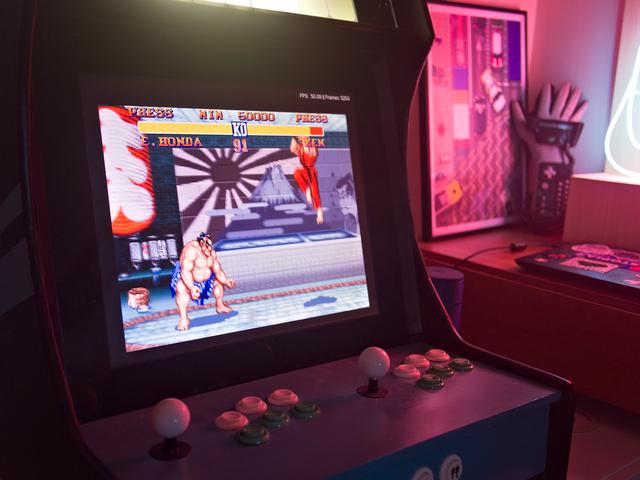

The Polybius arcade cabinet is an urban legend. It's been going around the gaming community for some time now. In short, the legend tells of a mysterious arcade machine appearing in an arcade, somewhere in Portland in the 80s. This arcade was rumoured to be an experiment in mind control by the US Government, with men in black arriving to remove the machines soon after. The whole thing is a wonderful modern myth; Ahoy has an excellent video about the Polybius story which is well worth your time.
Of course, this means folks in the arcade enthusiast world love to make cabinets with the Polybius logo and theme, and I'm certainly no exception. I've wanted a way to play old retro games for a while and - for arcade games especially - a retro arcade cabinet with clicky buttons and joysticks is the only way. Sadly, I don't have a lot of space for a full cabinet so I went down the bartop route.
This is also my first blog post with a video! I've decided to make a little foray into YouTube. Well, Vimeo and PeerTube as well (YouTube does have a lot of problems). Sometimes, video is the better medium for telling a story. The video at the top shows most of the processes and the final working cabinet. I've embedded the video from Peertube as I think this is the best option amongst the various video providers, but you can also watch on Youtube and Vimeo if you prefer.

I found a plan on this website. It's not a bad start but the design misses a few key dimensions - we had to work out a few of them with a bit of maths. Still, it's something. We built the cabinet out of 12mm plywood which is quite strong, but not wide enough to take a T-Mould - indeed, the plywood laminate would split apart even if it was wide enough. Typically, arcade cabs are made from cheaper materials such as chipboard, but my Dad isn't a fan of such things.
slagcoin has an excellent review of button placements. They provide really good layouts with complete measurements for drilling the button and joystick holes. We went for a classic, two player 6 button setup, with extra start and select buttons on the front of the cab.
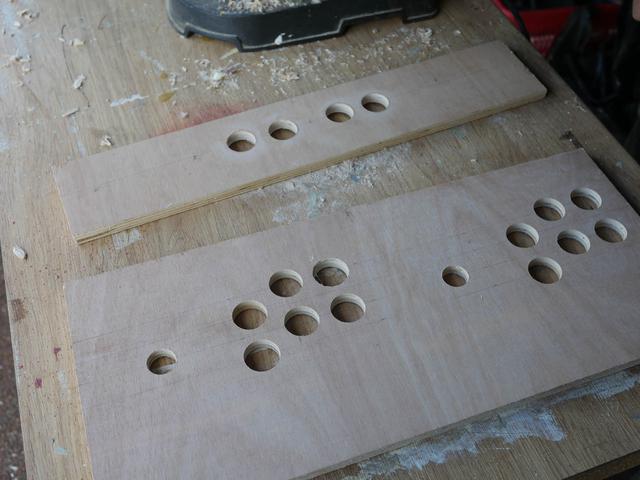
With the holes drilled and the wood cut out, we added a few little touches such as rounding the edges with a router to give a nicer finish. Filling in any gaps with wood filler, glue and sawdust, finishing with a good sanding. Prepping the surface was very important as we wanted that classic, plasticky looking finish for an 80s looking cabinet. A couple of layers of undercoat were applied to the assembled body to get that required smoothness.
The original Polybius cabinet is a very dull affair, adding to it's mystique no doubt! I wanted something a little more hauntologically 80s. You know - the neon, the pink and blue, Kung Fury 80s that never really existed. Looking around the internet I spotted a couple of Polybius designs that fit the bill. I went with a greeny-blue for the stripes and the control deck, matt black for the majority of the shell, with green and white controls. The overall scheme looks pretty good I think.
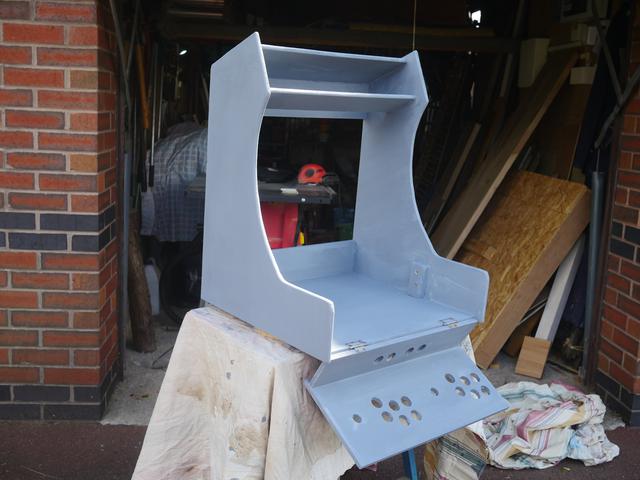
Finding somewhere that would print out semi transparent vinyl was really tricky. I went with sticker-shop in the end, getting 3 versions of the Polybius logo. I made a few mistakes though. Firstly, the sections that should have been black were clear - I'd forgotten to black-out the text surround. Secondly, the adhesive was on the back of the vinyl, not the front. Finally, for some reason the vinyl has a slight spotty effect. Close up, there is a regular pattern of bumps across the surface. No idea why that is - something to do with the manufacturing process I guess?
In the end, my Mum - who is a dab hand with a paintbrush - painted in the background areas with black acrylic paint. She did an excellent job - you can't really tell it's been done by hand unless you've been told what to look for. A lucky save for me there!
We bought the wood from Alty's, a local builders merchant in the North West. The perspex cam from Hamar Acrylic in London - a staple of the hacking community in the East End - the Maker's choice! They did a really good job of cutting it to size and packaging it up for me so I could cycle home with it.
One trick I learned is one can use the thin plastic wrapping on the perspex sheet as a mask. Using a sharp craft knife, you can cut off the bits you want to spray paint. We needed to black-out the border areas on the big sheet, leaving a clear area in the middle for the screen. This technique worked really well, resulting in a crisp edge.
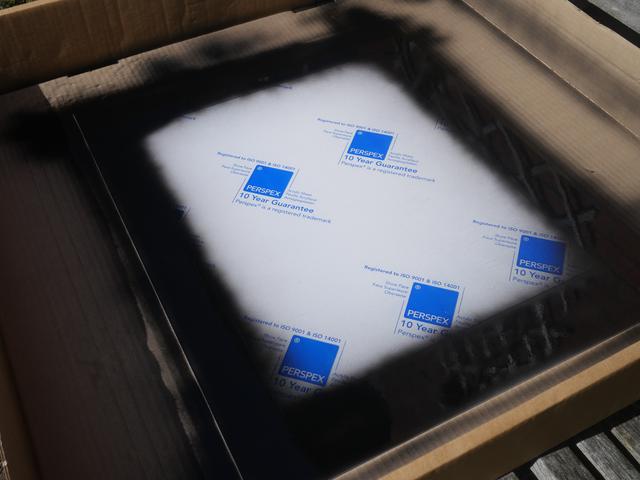
As mentioned above, I'd made a few mistakes with the marquee. I should have laser-cut a template for spray-painting the black-out areas. In the end, once my Mum had painted the background in, we sandwiched the vinyl between two sheets of thin perspex. We already had two holes drilled for mounting the sheets in place (Hamar will do these sorts of cuts for you when you order with them), so installation wasn't a problem.
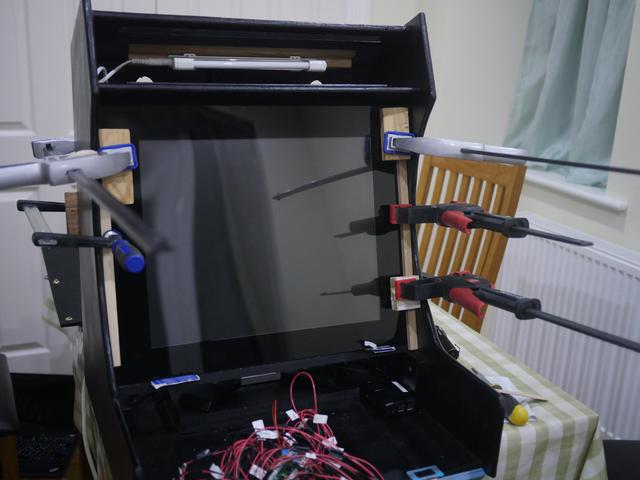
The electronics consists of a few things:
The speakers, LCD panel and RaspberryPi I managed to grab from eBay or else I had them lying around. None were too expensive. I managed to find a bar speaker with screw mounts which was perfect for mounting in the top of the cabinet behind the marquee. The Dell LCD panel I found has the lovely feature of automatically turning on when the power comes on, so there was no need to modify the power switch on the front. I took off most of the plastic bezel on the front of the screen to make it as level as possible, leaving the smallest gap possible between screen and perspex.
I bought 16 buttons and two joysticks from Arcadeworld UK - I went for Seimitsu gear in the end. They seem pretty reasonable and clicky in a very pleasing way.
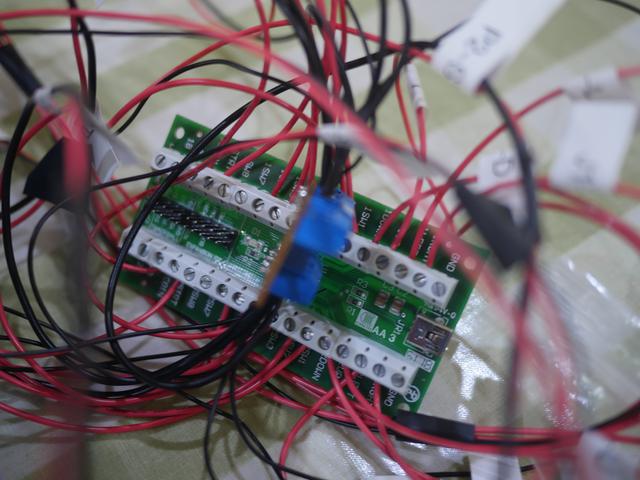
The light at the top is a small bar-light I picked up from the local hardware shop. It's easy to mount and install. However, one does need to diffuse the light coming from it. There isn't enough distance for the light to disperse on it's own. Fortunately, I had an old LCD monitor that wasn't working anymore. I took it apart and found a lens like sheet and a pretty good diffuser. I decided to use the latter to spread the light around a bit more. It's not perfect but it's a definite improvement.
I made the mistake of soldering the wires directly onto the microswitches. It's much better, and maybe quicker, to use crimps and spade connectors. Eventually, I'll need to replace the switches and it will be a pain. For now though, it's fine. I do recommend using a label printer to mark every wire. It'll save you a lot of time when you come to wiring in the iPac. You'll need extra sockets for all the ground connectors or some other method to ground out all the controls. There are a lot of ground wires!
I use the RetroPi distribution and a slew of emulators on the cabinet. Installation is pretty straight forward with programs like the new RaspberryPi OS imager. Once installed, there are a few things worth setting up like the time and region, overclocking and such, but it all depends on the Pi you are using. I'm using a RaspberryPi 3 I had knocking around. It's probably the minimum spec for this - you won't get the 3D stuff like Tekken working well, but most 2D stuff should be fine.
The iPac 2 has some software on windows for setting it up, but as I recall, it pretty much worked out of the box. It sets itself up as a keyboard device - all you need to do is setup the key bindings in Retroarch / RetroPi.
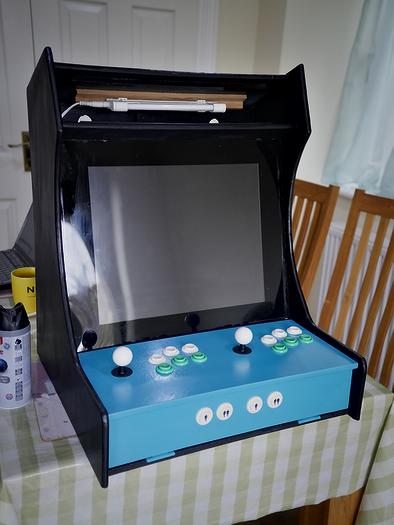
Lets take a look at the rough costs:
The grand total - roughly £250. All in all, that isn't too bad for a custom cab that I'll treasure for a long time. If what you want is just something to play retro games on, there are many other options that are cheaper, take less time to build and are smaller. However, the time I spent with my parents, putting this together, was priceless. As such, it means a lot to me and it makes it all the more fun to play on. I'd definitely recommend giving this a go if you like retro games and fancy experiencing them in that arcade way.
